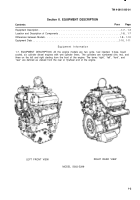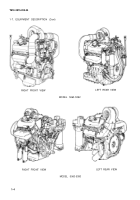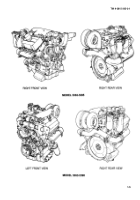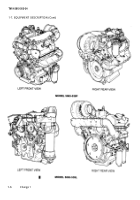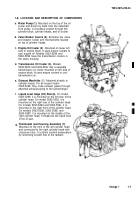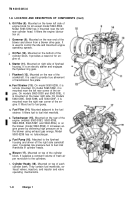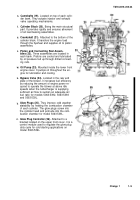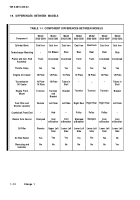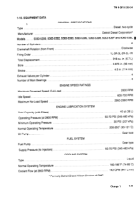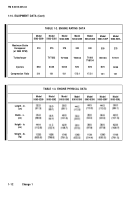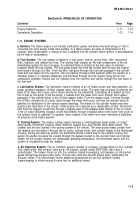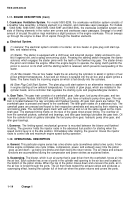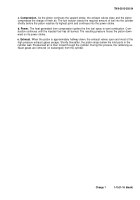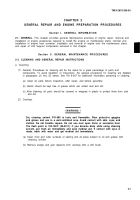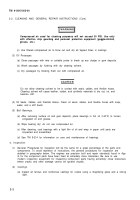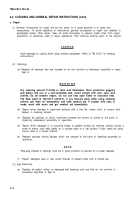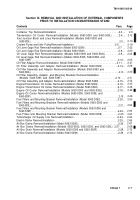TM-9-2815-205-34 - Page 25 of 596
TM 9-2815-205-34
Section Ill. PRINCIPLES OF OPERATION
Contents
Para
Page
Engine Systems . . . . . . . . . . . . . . . . . . . . . . . . . . . . . . . . . . . . . . . . . . . . . . . . . . . . . . 1-11 . . . 1-13
Operational Description . . . . . . . . . . . . . . . . . . . . . . . . . . . . . . . . . . . . . . . . . . . . . . . . . .1-12 . . . 1-14
1-11. ENGINE SYSTEMS
a. General.
The diesel engine is an internal combustion power unit where the heat energy of fuel is
converted into work energy inside thee cyIinder. In a diesel engine, air alone is compressed in the
cylinder. After compression, a charge of fuel is sprayed into the cylinder where ignition is accomplished
by the heat of compression.
b. Fuel System.
The fuel system consists of a fuel pump, strainer (prima filter), filter (secondary
filter), injectors, and related fuel lines. The intense heat created by the high compression of the air
immediately ignites the fine fuel spray. A restricted fitting is located at the fuel return to maintain
pressure within the fuel system. The fuel pump draws fuel from the vehicle tank through the strainer
and forces it through the filter. From the filter, fuel goes through the fuel inlet passage in the cylinder
head and fuel tubes into the injectors. The fuel passes through a filter element within the injector to a
chamber where it is metered, displaced, and atomized through the fuel injector spray tip into the
combustion chamber. Excess fuel not injected cools the injectors and returns through the fuel tubes to
the fuel tank.
c. Lubrication System.
The lubrication system consists of an oil intake screen and tube assembly, oil
pump, pressure regulator, oil filter, bypass valve, and oil cooler. The gear type oil pump is bolted to the
back of the lower front cover and is driven directly by the crankshaft. Lubricating oil is picked up from
the oil pan by the pump. From the pump, it passes from the lower front cover through short gallery
passages in the cylinder block to the oil filter adapter plate. From the adapter plate, oil flows through
the oil filter, through the oil cooler, back through the lower front cover, and into the cylinder block oil
galleries for distribution to the various engine bearings. The drains for the cylinder heads and other
engine parts lead back to the oil pan. Clean engine oil is assured by a replaceable oil filter. Should the
filter become clogged, oil will flow through a bypass valve in the adapter plate directly to the oil cooler.
If the oil cooler becomes clogged, oil will flow directly through a bypass valve in the lower front cover to
the cylinder block oil galleries. A regulator valve located in the lower front cover maintains a stabilized
oil pressure at all engine speeds.
d. Cooling System.
The engine cooling system includes a centrifugal-type water pump, oil cooler
water jacket, thermostat housing, water manifold, bypass line, and cylinder block water jacket. The
radiator and fan are located in the cooling system of the vehicle. The water pump draws coolant from
the radiator and circulates it through the oil cooler, cylinder block, and cylinder heads to the thermostat
housing. During the warm-up period, the thermostat blocks coolant flow to the radiator. During this
period, the pump circulates the coolant through the bypass system to the cylinder block and cylinder
heads. As the coolant reaches the designated operating temperature, the thermostat opens and the
coolant is circulated through the radiator.
e. Air Induction System.
The air induction system consists of a blower, cylinder block air box, cylinder
liner intake ports, and exhaust valve ports. All engines, except model 5063-5299, also have a
turbocharger. The blower forces air into the cylinders (called scavenging) and sweeps out the burned
gases through the exhaust valve ports. This air also cools the internal engine parts, particularly the
exhaust valves. The turbocharger forces additional pressurized air into the cylinders (called
supercharging) to allow burning of more fuel for additional power.
1-13
Back to Top

